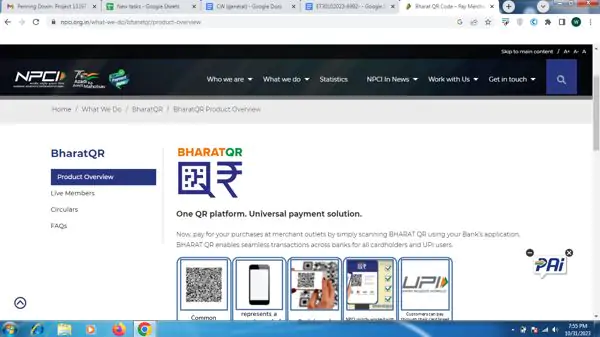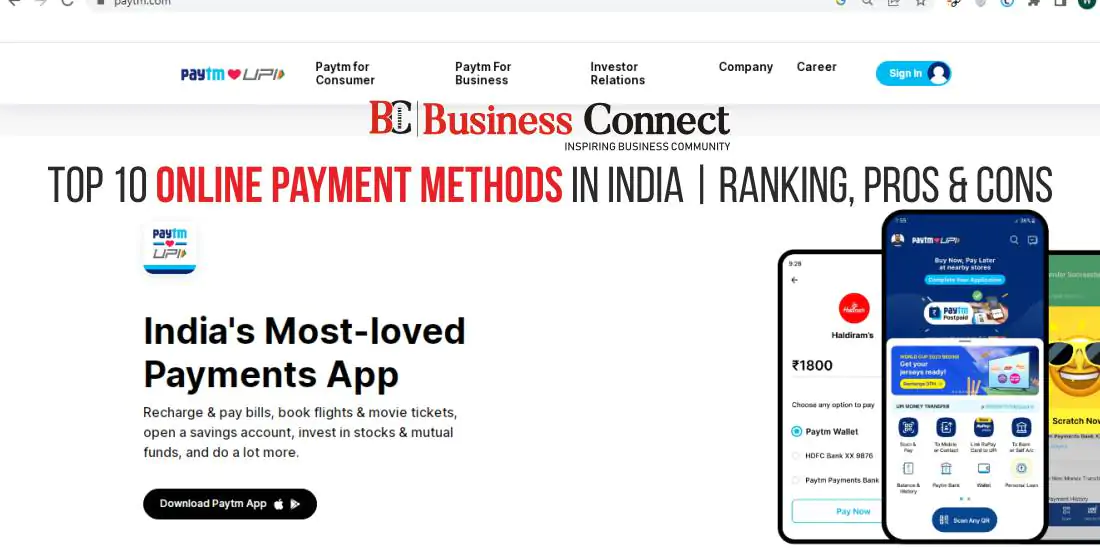Top 10 Online Payment Methods in India | Ranking, Pros & Cons
India is noticing a huge revolution in the world of financial technologies. As the nation moves toward a cashless economy, digitized payment innovations are constantly welcomed with open arms. Scroll through this article to learn in detail about India’s top 10 online payment methods.
01. UPI (Unified Payments Interface)
UPI is one of the first initiatives in India to promote cashless transactions. This convenient and accessible method is available through smartphones. You won’t need bank account details while making UPI transactions because only a UPI PIN is necessary.
| Pros:
● No additional charges ● Quick and easy transactions ● A high upper limit for transactions |
Cons:
● Server issues can cause payment delays |
02. Paytm

Paytm is highly beneficial for mobile recharges, DTH recharges, and more. You can also use this online payment method to pay electricity bills, book tickets, and more. Moreover, multiple online bookmakers allow you to place thrilling bets accepting Paytm as a payment method.
| Pros:
● Smooth transactions ● Fast and secure ● Make different types of payments |
Cons:
● Slow customer support |
03. Debit and Credit Cards
Debit and credit cards are one of the oldest methods for facilitating cashless payments. You must provide your card details or swipe the card to pay using it.
| Pros:
● Safe and secure ● Supports different types of payments ● Widely accepted mode of payment |
Cons:
● Might charge extra fees in some cases |
04. Net Banking
Net banking is an initiative by banks to offer many financial and non-financial products to customers. Net banking facilities include fund transfers, requesting demand drafts, and more securely and conveniently. All individuals with a savings or current account can sign up for net banking.
| Pros:
● Password-protected banking system ● Fast processing of bill payments ● Setting up or canceling bill payments |
Cons:
● Unavailable when bank servers are down |
05. Cash on Delivery
While shopping on eCommerce sites, you can also go with the cash-on-delivery option. This option means you don’t need to pay online while placing an order. You can pay the price when the item arrives at your doorstep.
| Pros:
● No risk of online fraud ● No need to depend on payment cards ● High flexibility for the customer |
Cons:
● Some sellers might not offer the cash-on-delivery option |
06. IMPS (Immediate Payment Service)
IMPS enables you to transfer funds instantly with zero downtime. The money gets credited or transferred to the recipient’s account in a few minutes instead of hours or days. The recipient’s number and an MMID, a unique identification number, are necessary for making an IMPS. Since you don’t need the recipient’s bank account number or IFSC code, this online payment method is a lot more convenient.
| Pros:
● Provides high security with two-factor authentication and a one-time password ● Accessible through smartphones ● Less expensive than traditional cash deposits or bank transfers |
Cons:
● Limited transaction amount |
07. Bharat QR Code

Bharat QR Code enables customers to make digital payments to merchants without using a Point-of-Sale swiping machine. It allows the customers of all banks to make payments through their smartphones. It is extremely beneficial for merchants because they don’t need to invest in the POS machine. Moreover, they can do away with the transaction fees associated with banks for leveraging the PoS terminal.
| Pros:
● Developed by major payment gateways operating in India ● Low transaction cost ● Supported by major banks in India |
Cons:
● No cashback offers are available |
08. NEFT (National Electronic Funds Transfer)
National Electronic Funds Transfer is a method of online payment between two bank accounts. A large number of banks in India support this method of payment. NEFT allows you to send up to Rs 10 lakh at a time. NEFT can be done through net banking or mobile banking to facilitate the domestic transfer of funds.
| Pros:
● Overseen by RBI ● Comes with two-factor authentication ● Available 24*7 |
Cons:
● Money does not get transferred instantly |
09. RTGS (Real-Time Gross Settlement)
RTGS is usually suitable for high-value transactions in real time. Large business payments, interbank transfers, and transactions involving a large amount often use RTGS. Once an RTGS transaction gets approved, the funds reach the recipient without delays.
| Pros:
● Suitable for high-value transactions ● Highly secure method ● No risk of netted or bundling transactions |
Cons:
● More expensive than other electronic methods of payments |
10. Aadhaar-Enabled Payment System (AePS)
AEPS is a blessing in disguise in areas with bank branches nearby. This payment method involves customers entering their Aadhaar number and providing their thumbprint to make deposits or withdrawals. Customers don’t need a smartphone or other technological devices to make payments.
| Pros:
● No need for a passbook, debit card, or other bank documents for payments ● Fast and free payment system ● Supports fund transfers from one bank to another |
Cons:
● Payments won’t be possible when there are internet issues in the area |
Business Connect Suggests Different Criteria for Ranking Online Payment Systems in India
After learning about the top 10 online payment methods in India, you should know the top criteria for ranking them:
- Popularity: The first criterion for ranking the payment methods is determining their popularity among users.
- Security: It’s important to find an online payment method that incorporates all the latest security measures to guarantee the safety of your funds.
- User-Friendliness: Ranking an online payment method requires understanding whether it is convenient and simple for users.
- Widespread Acceptance: Another criterion for ranking online payment methods is where you can use them.
Conclusion
The best method for making online payments depends on your convenience and comfort. It is essential to explore the benefits and drawbacks of different online payment methods to determine which would be the best for you.
Must Read:-
- Stock Market Update
- Top 10 shoe brands in India for men & women 2023
- Top 10 Adorable Gifts for Your Special One
- Top 10 Countries with Maximum Indian Population as Citizens
- Top 10 Small Business Statistics You Need to Know For 2023
- Top 10 highest-paid CEO in the World
- Top 10 richest person of India
- Top 10 Highest-Paid CEOs of India


